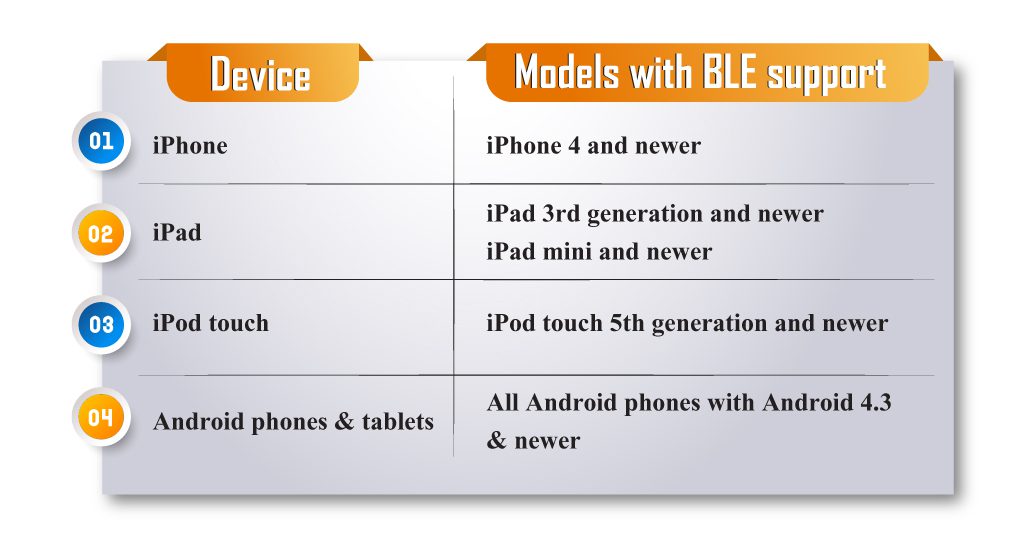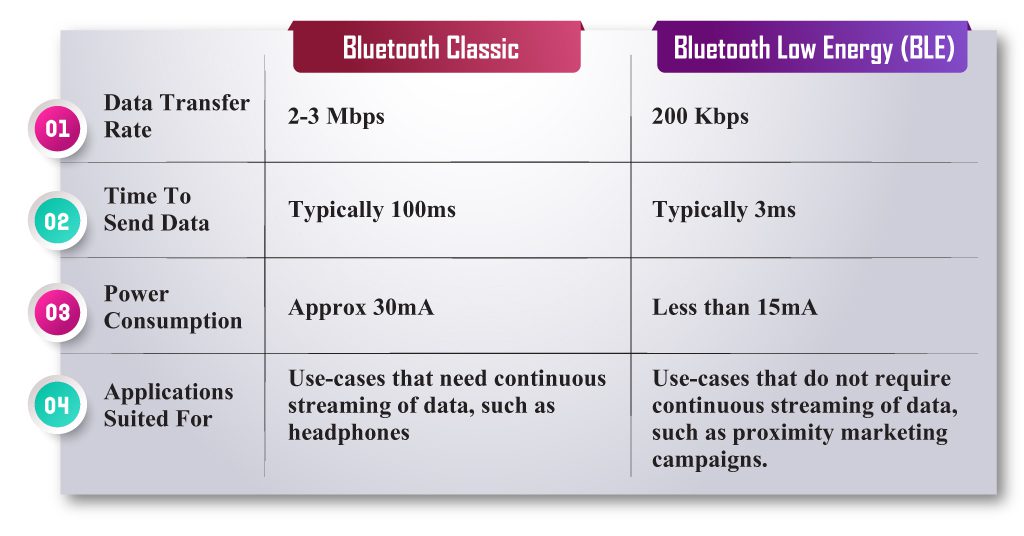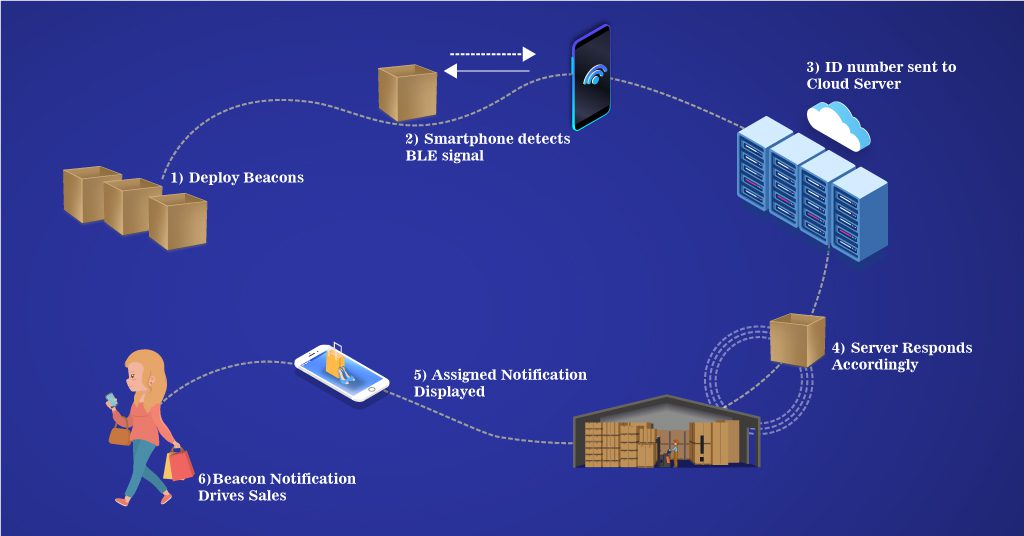What is BLE? What does it depend on?

- Aug 05, 2019
- by Spikebot
What is BLE? What does it depend on?
BLE represents Bluetooth Low Energy (Bluetooth LE, and advertised as Bluetooth Smart).
BLE is a type of wireless communication structured particularly for short-range communication. BLE is fundamentally the same as Wi-Fi as it allows gadgets to speak with one another. In any case, BLE is intended for circumstances where battery life is favored over high data transfer speeds. The measure of data you have to transfer to a guest’s smartphone is very less. Consequently BLE compatible beacons carry out the responsibility rapidly without depleting the battery.
Most smartphones and tablets today are BLE compatible, which means they can consistently speak with Bluetooth enabled wireless earphones, advanced signage, vehicle sound systems, wellness trackers, smart-watches and equipment gadgets like signals.
How does BLE innovation work?
BLE data transfer is basically one-way communication. Let’s take a case of BLE beacons attempting to speak with a smartphone in its proximity – a Bluetooth Low Energy beacon communicates parcels of data at regular intervals of time. These data packets are recognized by application/pre-introduced benefits on smartphones. This BLE communication triggers activities, for example, pushing a message or prompting an application.
To save energy and give higher data transfer speed, the whole BLE communication system comprises of 40 frequency channels, which are separated by 2MHz. 3 of these channels are the primary advertisement channels while the rest of the 37 channels are secondary channels, known as data channels. The Bluetooth communication begins with the 3 primary advertisement channels and after that offloads to the secondary channels.
What gadgets support BLE? Which Android telephones support BLE?
Most smartphones and tablets which are built since 2012 support BLE. Since Android telephones differ broadly, a few models may support BLE, while others support the older version of Bluetooth. The table below abridges which iOS gadgets have BLE.

Bluetooth Classic vs Bluetooth Low Energy
What is Bluetooth? How is Bluetooth Low Energy (BLE) different?
There are two noteworthy advancements inside the core specifications of Bluetooth – Bluetooth classic and Bluetooth Smart (Bluetooth Low Energy). The real difference between Bluetooth classic and Bluetooth low energy lies in the power utilization in each scenario.
There are other factors as well which show why Bluetooth Smart is preferred to classic Bluetooth Classic:
Power utilization
This is the thing that makes BLE so exceptional! Organizations can utilize only four batteries to control Bluetooth gadgets for months or even years. Nonetheless, for classic Bluetooth, given the higher data throughput, its capacity utilization can be very high.
Applications
Classic Bluetooth is extraordinary for applications that require continuous data streaming, for instance, earphones. While, BLE is appropriate for applications that function properly with transfer of data in periods, and consequently reduces a lot of battery use. This makes BLE suitable for IoT and similar applications.
Simultaneous connections
BLE can simultaneously set up to 20 connections. It supports progressively synchronous connections since it transfers small data packets and sets up speedy connections. On the other hand Classic Bluetooth can initiate only 7 connections simultaneously.

What is virtual BLE?
Rather than a physical beacon that should be conveyed, virtual BLE is just a beacon point that is added to existing Wi-Fi systems. The BLE communicate usefulness accomplished through a BLE reception apparatus is added to a Wi-Fi passageway. This kills the requirement for beacons and batteries. Such virtual BLE systems can be utilized for indoor route.
BLE innovation and beacons
What is a Bluetooth Low Energy (BLE) beacon?
BLE beacons, as the name proposes are beacons that communicate through Bluetooth Low Energy. Beacons are little radio transmitters, deliberately mounted all through areas, to communicate BLE signals in a given range. This range relies upon the ability of the hardware. On a normal, a Bluetooth Low Energy beacon can transmit BLE signal to 80 meters. This BLE signal from the beacon is capable of setting off a particular activity significant to that particular area.
How is BLE technology used with beacons?
Beacons send an ID number by means of BLE channels, around 10 times each second. A Bluetooth-enabled device which is in proximity of the beacon grabs this ID number. At the point when an application or pre-installed service like ‘Google Nearby’ identifies the ID number, it connects it to an activity, for example, download an application, or some content which is stored on the cloud, and shows it on the smartphone.

BLE use cases
Proximity Marketing
It is very common to know that the shoppers hate the promotional messages which are out of context. Therefore it is very important for the businesses to be smart in their promotional ideas. These battles must be incredibly customized and significant. This lifts the deals as well as increase brand loyalty. Organizations such as McDonald, Macy, Walmart and Lord and Taylor are making their campaigns very relevant for their guests.
Retargeting Ads
BLE beacon arrangements, like Beaconstac, enable organizations to contact guests even after they settle up with the store. When a guest connects with any in-store campaign, they are presented to a similar brand when they go on the web – Facebook or Google.
Asset Tracking
This is another well-known Bluetooth LE beacon use case. Rather than broadcasting IDs to cell phones, the BLE beacon “listens” to the interesting IDs of BLE labels connected to objects. Since these labels can be attached with sensors—for things, for example, light, stable, development, and temperature—the applications are many, from tracking the wheelchairs and infusion pumps in medical clinics to screening the speed, movement and vibration of an airport conveyor.
Indoor Navigation
GPS works incredible for outdoors – however we have all observed GPS arrangements go insane inside. BLE foundation works incredibly indoors and outdoors! A mix of three indoor beacons is adequate to locate the precise position of a smartphone. Indoor route utilizing BLE frameworks offers turn-by-turn directions, mark the important places and shows the recommended route. This is particularly useful for multi-story stores, shopping centers, and museums.
Virtual BLE invalidates the need a physical beacon in this specific use case. By locking onto existing Wi-Fi systems, beacon points can make a range that resembles a light emitting flashlight. More energy is pushed in front of the beacon antenna compared with the sides. This energy shapes a power dispersion ellipse.
The location of a client is found by defining a probability weight to each point in the map. In the wake of figuring the expected signal strength and the measured signal strength, the location of device is determined with maximum accuracy.
